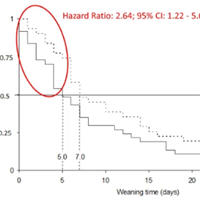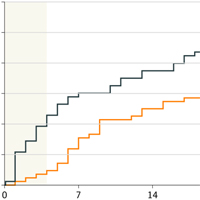Tag: infusion

Replacement of Fentanyl Infusion by Enteral Methadone Decreases the Weaning Time From Mechanical Ventilation
The introduction of enteral methadone during weaning from sedation and analgesia in mechanically ventilated patients resulted in a decrease in the weaning time from mechanical ventilation (MV). A double-blind randomized... read more

Conversion From Continuous Infusion Fentanyl to Continuous Infusion Hydromorphone in the Pediatric ICU
A median 14% fentanyl dose reduction was noted when transitioning to hydromorphone. Further exploration is needed to determine if opioid rotations with hydromorphone can reduce opioid/sedative exposure. A total of 36 children... read more

Supraclavicular Subclavian Vein Catheterization – The Forgotten Central Line
While the supraclavicular approach to the subclavian vein has been described since 1965, it is generally employed much less often than the "traditional" infraclavicular approach. Although randomized trials are lacking, the... read more

Tocilizumorelikeit? The latest data on Tocilizumab
Our hats were then blown away when the REMAP-CAP team and the UK government fired an evidence-based carpet bomb in our direction. We saw a trial press release, a preprint article, an alert letter from the MHRA/DHSC, national... read more

Dexmedetomidine for Prolonged Sedation in the PICU
High-quality data on dexmedetomidine use for prolonged sedation and a consensus on correct dosing and weaning protocols in children are currently missing. Infusion of dexmedetomidine can be considered relatively safe in pediatrics... read more

Tranexamic Acid Has Nominal Benefit for TBI
Studies examining the use of tranexamic acid (TXA) inescapably seem to pit our rigorous methodological demons against our practical clinical angels. The CRASH-2 trial randomized 20,211 adult trauma patients presenting... read more

Best Practice Advisories Improve Sedation Protocol Compliance in the ICU
Best practice advisories can be effectively used in ICUs to improve sedation protocol compliance and may mitigate potential propofol-related hazardous conditions. Best practice advisories should undergo continuous quality... read more

Automated Anesthetic Management Outperforms Manual Control and May Have an Impact on Delayed Neurocognitive Recovery
Among older, non-frail patients undergoing moderate and high-risk noncardiac surgery, an automated anesthetic management using the combination of three independent closed-loop systems outperformed manual control and may have... read more

Critical Care Opioids Impact in the 21st Century
Critical Care is impacted by opioids in multiple ways. Not only do they form the backbone of managing pain and sedation in the intensive care unit (ICU), the burgeoning opioid epidemic also feeds into opioid-related ICU admissions.... read more

Modified Version of the ACC’s low-dose 4PCC Warfarin Reversal Option Achieves Similar Outcomes for Lowering INR
A modified version of the American College of Cardiology (ACC) low-dose four factor prothrombin complex concentrate (4PCC) option for warfarin reversal achieves similar outcomes for lowering International Normalized Ratio... read more

Fentanyl Infusion Pharmacokinetics Variables in Obese and Nonobese Children
The differences in total clearance (CLS) may increase less than proportional to weight in obese children greater than 6-year-olds, while volume of distribution at steady state increases more than proportional to weight in... read more

Optimizing Therapy of Bloodstream Infection Due to Extended-spectrum β-lactamase-producing Enterobacteriaceae
Carbapenems should be used in patients with serious infections; alternatives could be used individually, particularly for definitive treatment of patients with milder presentations. Meropenem and imipenem are the drugs... read more

Transfusions Stuck in an Endless Cycle of Denial
Each publication from Maitland, et al., gives us a glimpse of a greater medical truth, but our view is obstructed by questions about external validity. This group published the landmark FEAST trial that questioned the... read more

Effect of Vitamin C Infusion on Organ Failure in Patients With Sepsis and ARDS
In this preliminary study of patients with sepsis and Acute Respiratory Distress Syndrome (ARDS), a 96-hour infusion of vitamin C compared with placebo did not significantly improve organ dysfunction scores or alter markers... read more




